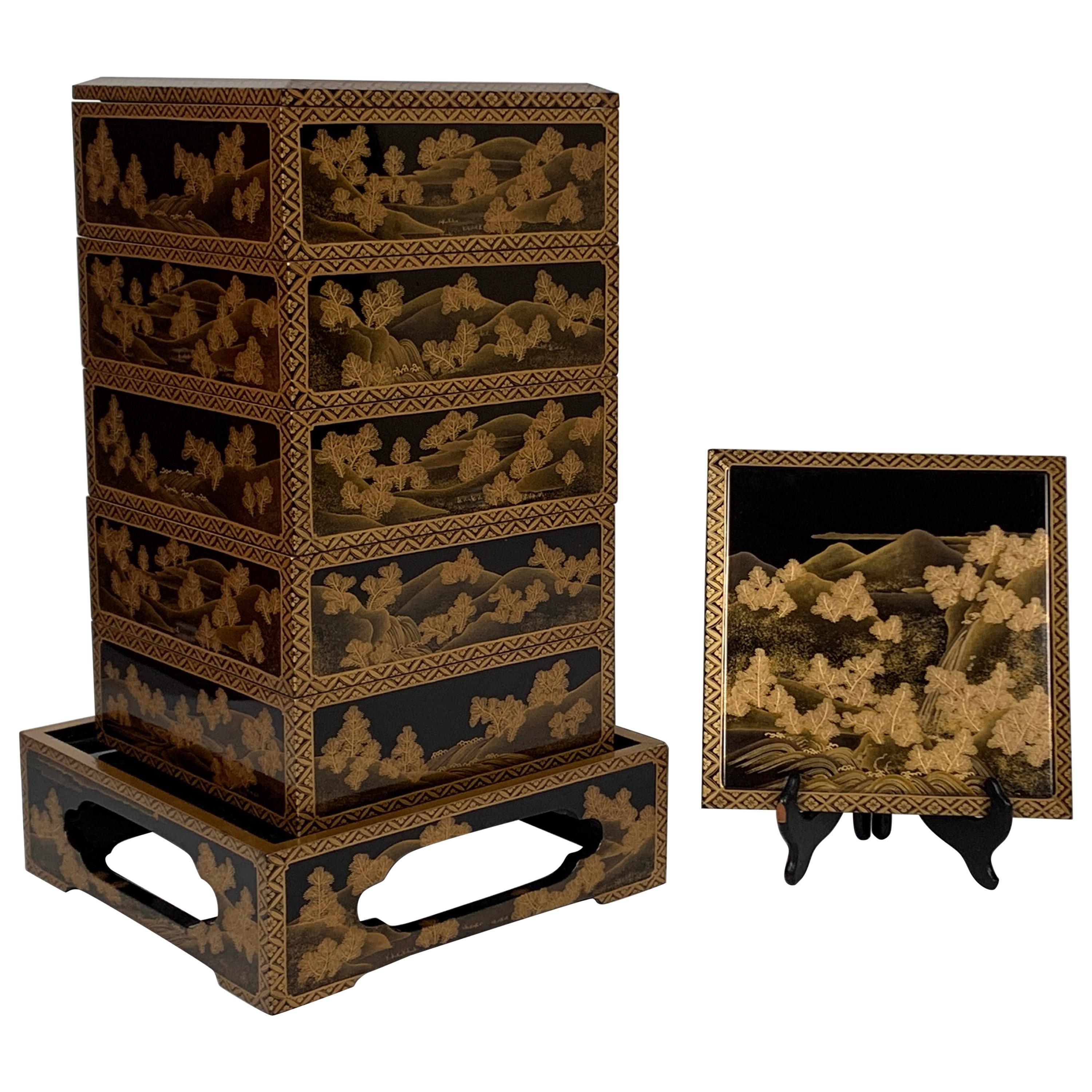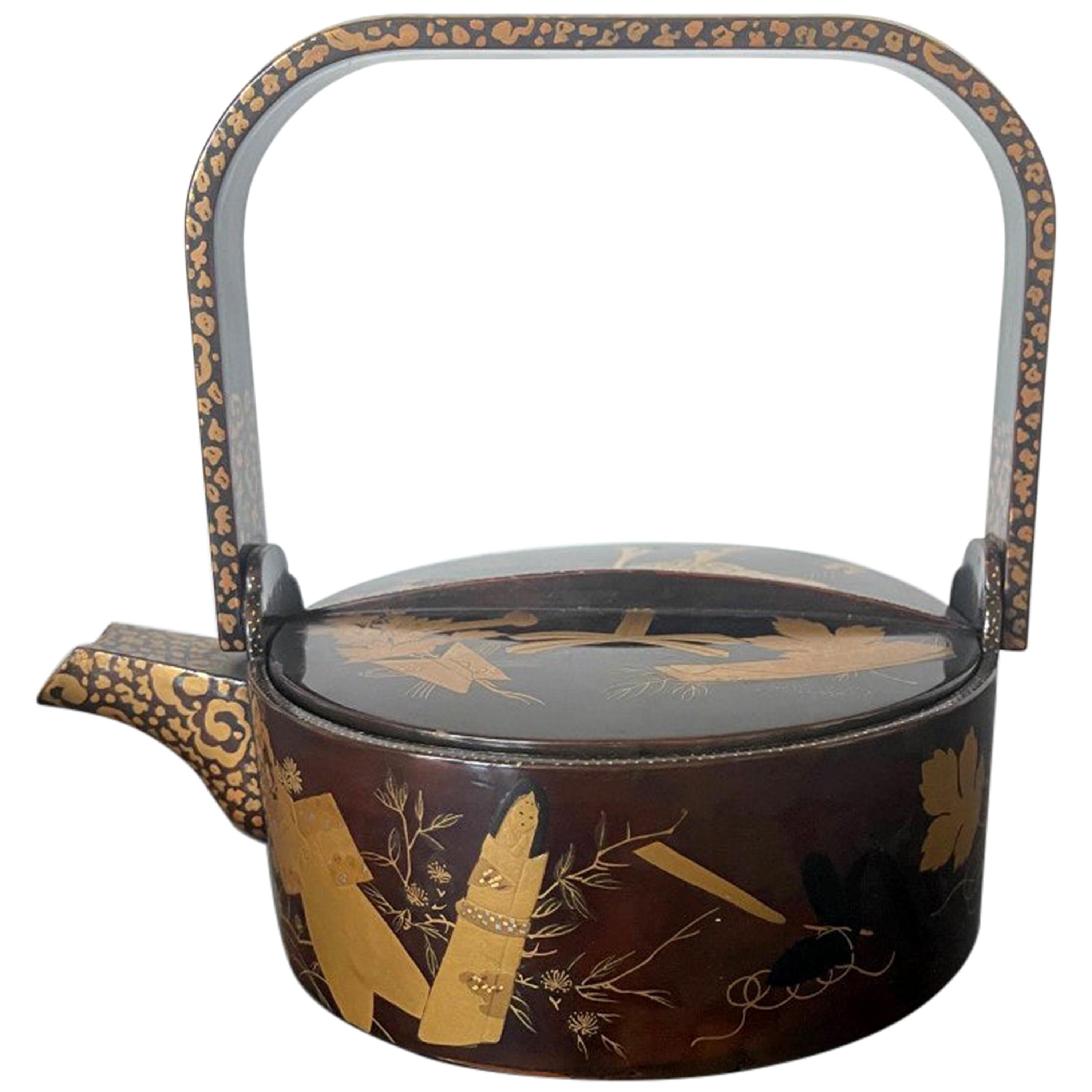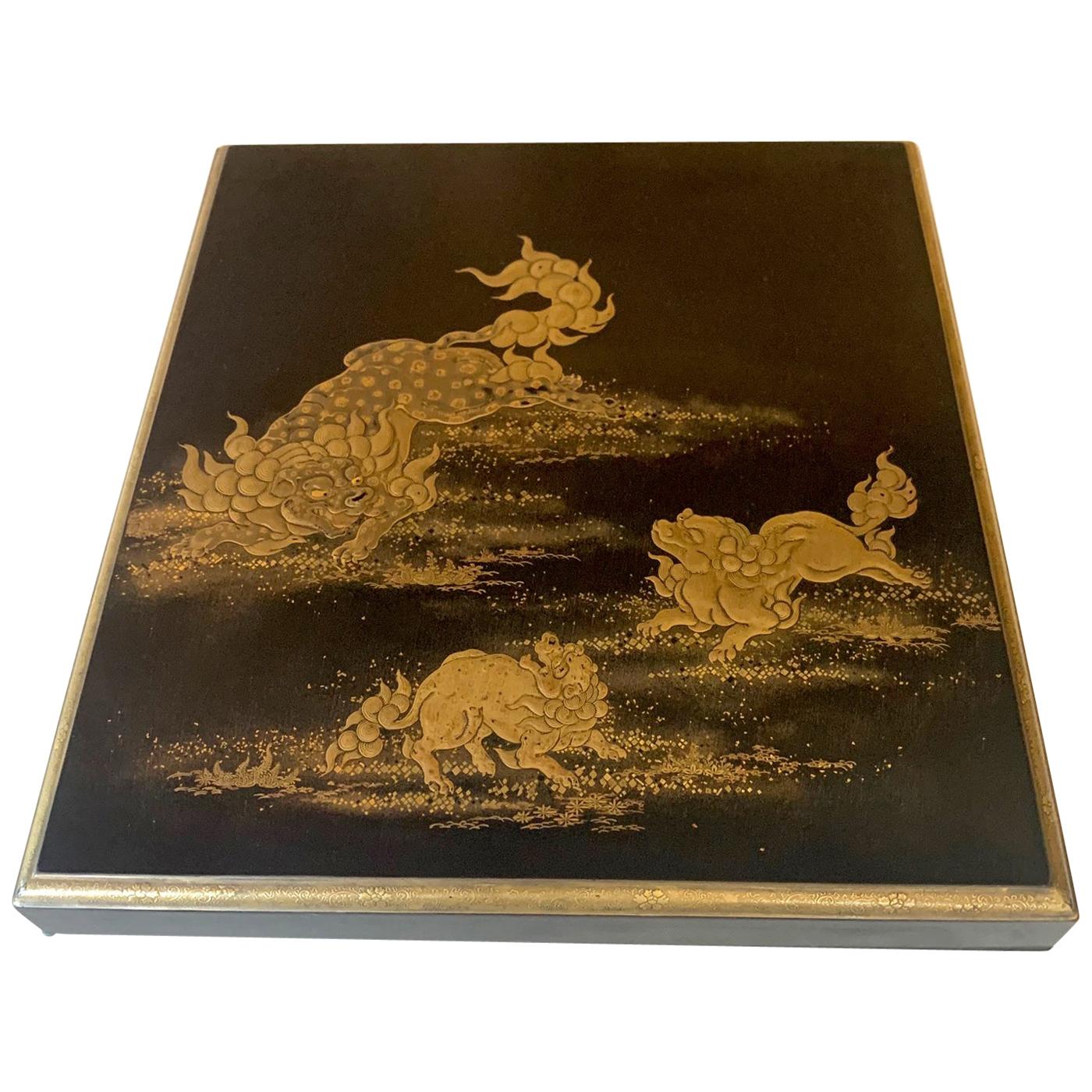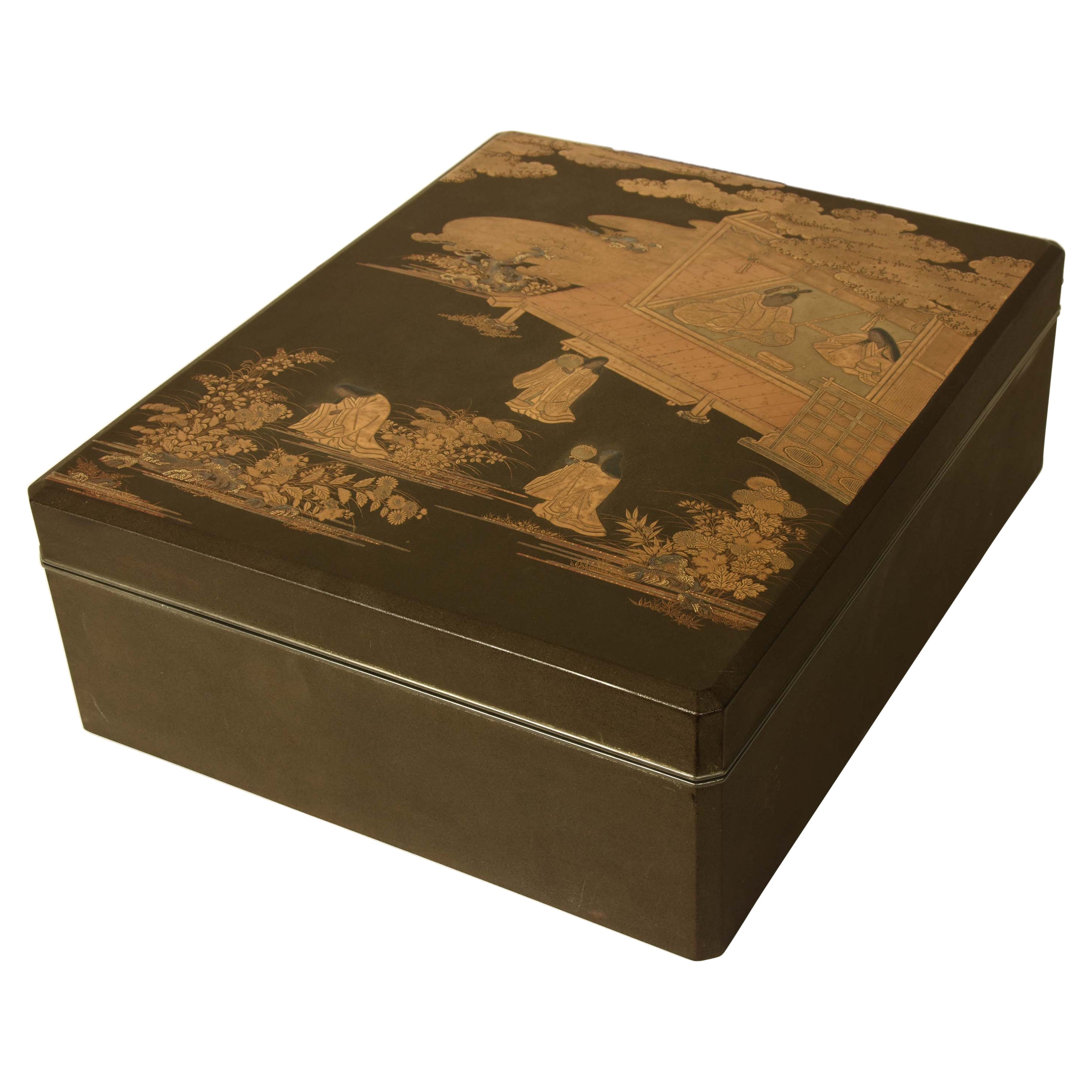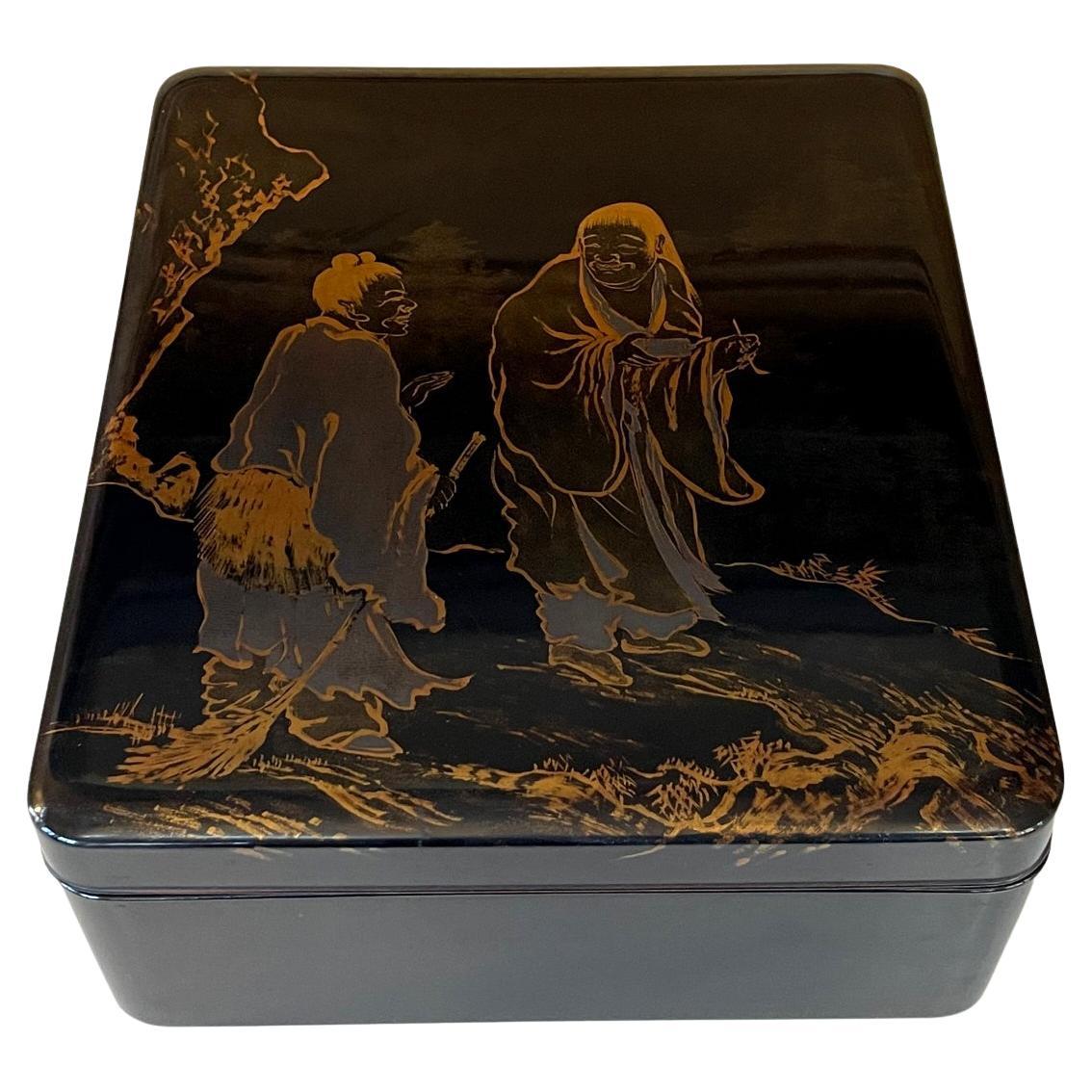Items Similar to Signed Japanese White Lacquer and Maki-E Lacquer Tansu, Meiji Period
Want more images or videos?
Request additional images or videos from the seller
1 of 9
Signed Japanese White Lacquer and Maki-E Lacquer Tansu, Meiji Period
About the Item
The case decorated overall in crackle-glaze white lacquer and fitted with a patinated metal carrying handle over three tiers of small drawers. The first two tiers are comprised of a pair of short off-set drawers with organic-inspired metal pulls, over a single lower drawer fitted with a patinated metal bail handle, their fronts decorated with hand applied gold maki-e lacquer depicting a songbird amongst flowering branches.
Signed in characters on the underside.
- Dimensions:Height: 6 in (15.24 cm)Width: 6 in (15.24 cm)Depth: 3.25 in (8.26 cm)
- Style:Meiji (Of the Period)
- Materials and Techniques:
- Place of Origin:
- Period:
- Date of Manufacture:1868-1912
- Condition:Wear consistent with age and use. In very good overall condition with minor losses to the glazing.
- Seller Location:Ottawa, CA
- Reference Number:1stDibs: LU272837668143
About the Seller
5.0
Vetted Seller
These experienced sellers undergo a comprehensive evaluation by our team of in-house experts.
Established in 1989
1stDibs seller since 2017
Typical response time: <1 hour
- ShippingRetrieving quote...Ships From: Ottawa, Canada
- Return PolicyA return for this item may be initiated within 2 days of delivery.
More From This SellerView All
- Highly Decorative Antique Burmese Lacquered Betel Box / Kun-It, Circa 1900Located in Ottawa, OntarioThe vermillion lacquered cylindrical body decorated overall with repeating bands of curvilinear geometric motifs, the cover lifting to reveal both of its original trays intended to h...Category
Early 20th Century Burmese Lacquer
MaterialsLacquer, Bamboo
- A Very Fine Takamaki-e Lacquer Cheroot Case in the Manner of Shibata ZeshinBy Shibata ZeshinLocated in Ottawa, OntarioThe 'ishime' lacquered case consisting of two conforming molded sections with one sliding overtop the other, both sides decorated with hand painted gilt, silver & burnt dark russet (kasshoku) lacquers, depicting motifs in low relief of a rat with an acorn on one side and two acorns on the opposing. In Japanese culture rats are considered auspicious symbols of fertility & wealth, acorns symbolize prosperity & growth. Signed with characters and a mon on one edge. Takamaki-e is a lacquer technique in which metallic powders such as silver, gold, copper, pewter etc., are used in combination with lacquer & clay-dust to build up motifs in low relief. Please note that the color tones & hues of the lacquered motifs appear somewhat more vibrant in the images due to ambient lighting conditions. Regarding the opinion stating the superior quality of this fine example being likened to works associated with those by Shibata...Category
Antique 1870s Japanese Meiji Lacquer
MaterialsLacquer
- Very Fine & Large Japanese Bronze & Mixed Metal Vase, Meiji PeriodLocated in Ottawa, OntarioA large and very fine Meiji Period (1868-1912) patinated and mixed metal bronze vase of ovoid form, richly decorated with raised motifs of flying cranes accented with silver-overlay,...Category
Early 20th Century Japanese Meiji Metalwork
MaterialsSilver, Bronze
- Very Fine Pair of Japanese Miniature Cloisonne Vases, Meiji Period (1868-1912)Located in Ottawa, OntarioBoth hexagonal panelled bodies exquisitely decorated by hand with multi-coloured enamels, illustrating directionally opposing vignettes of songbirds perched among flowering prunus ag...Category
Antique Early 1900s Japanese Meiji Vases
MaterialsCopper, Enamel
- Regency Period Brass Bound Rosewood Campaign Writing Box, England, Circa 1815Located in Ottawa, OntarioA superior Regency period brass bound writing box constructed of richly figured Brazilian rosewood, the hinged top inset with a blank brass cartouche and opening to an interior fitted for inkwells & writing implements, including two replace gilt-tooled leather writing panels that cover document compartments, one housing three concealed spring activated ’secret’’ drawers. The interior also featuring a hinged arm that elevates to support the top when being used as a reading lectern...Category
Antique Early 19th Century English Regency Decorative Boxes
MaterialsBrass
- A Very Fine Edwardian Period Sterling Silver Tea Caddy by Asprey of London, 1908By Charles & George AspreyLocated in Ottawa, OntarioThis very fine & relatively heavy sterling silver tea caddy is of timeless design, showing an oval shaped canister decorated with an elegant reeded border to both the shoulder & base...Category
Early 20th Century English Edwardian Tea Caddies
MaterialsSterling Silver
You May Also Like
- Japanese Maki-e Lacquer Stacking Box, Jubako, Meiji Period, JapanLocated in Austin, TXA fine and impressive Japanese gold maki-e decorated black lacquer five-tier jubako with presentation tray, two lids, and the original tomobako storage box, Meiji period, late 19th c...Category
Antique Late 19th Century Japanese Meiji Lacquer
MaterialsLacquer
- Japanese Lacquer Maki-e Sake Ewer Meiji PeriodLocated in Atlanta, GAA Japanese lacquered wood sake ewer with maki-e design, circa late 19th century, Meiji period. The nicely decorated lacquerware is of a Classic sake ewer for...Category
Antique 1890s Japanese Japonisme Lacquer
MaterialsLacquer
- Japanese Meiji Period Antique Lacquer Box with Gold Maki-e DecorationLocated in New York, NYA fine antique Japanese Meji Period lacquer box decorated with a fan and a stylized star shaped window in the maki-e technique. The fan at the top right corner, fully opened depictin...Category
Antique 19th Century Japanese Meiji Lacquer
MaterialsLacquer
- Japanese Lacquer Box with Fine Maki-e Decoration Meiji PeriodLocated in Atlanta, GAA lacquered wood box with lid from Japan circa 19th century Meiji Period. The finely decorated box was used to store paper slips and small documents on the desk. It is overall finished with black lacquer (kuro) with sparse Mura-Nashiji effect outside and on the top surface of the lid, there are three Komainu, (sometimes known as Shishi or Japanese lions) frolicking and forming a circle in lively motion. Komainu are auspicious animals in Japanese cultures in both Shinto and Buddhism tradition. Originally from China, these animals symbolizes guardians to ward off evil spirits. Hiramaki-e was used in combination with carving and combing to render the lions with various surface textures. A gilt border with an slight angle was given to the lid and even the thin band is decorated with miniature floral scrolls. The interior of the box was finished in a dense nashiji. Underneath the lid, a cluster of peonies open lavishly by two gentle mounts. Takamaki-e (high relief) in both gold and silver were...Category
Antique Late 19th Century Japanese Japonisme Lacquer
MaterialsWood, Lacquer
- Japanese Black Lacquer Document Box with Gold Maki e Design, Meiji PeriodLocated in Prahran, VictoriaAn antique black lacquer document box with an exquisitely detailed, finely wrought design from The Tale of the Genji depicted in gold maki e across the lid. Internally, the box is de...Category
Early 20th Century Japanese Lacquer
MaterialsWood, Lacquer
- Japanese Lacquer Maki-E Tiered Suzuribako and RyoshibakoLocated in Atlanta, GAA Japanese roiro lacquer scholar combo box with an upper tier of inkstone box (Suzuribako) and a lower document box (Ryoshibako) circa 1910-30s (end of Meiji to Showa period). The high glossy box was beautifully decorated with an image of the famously eccentric Buddhist monks Hanshan and Shide (known in Japan as Kanzan and Jittoku). Often as a pair, they have been a popular motif in Japanese Zen painting...Category
Vintage 1920s Japanese Meiji Lacquer
MaterialsStone, Metal
Recently Viewed
View AllMore Ways To Browse
White Lacquer
White Lacquer Furniture
Pair Of Lacquer
Century Furniture White Lacquer
Lacquer Signed
Lacquer With Drawer
Metal Pulls
Small Lacquer Metal
White Lacquer Pair
Lacquer Organic
Pair Of Short
Off White Antique Furniture
Antique Handles And Pulls
Antique Furniture Handles And Pulls
White Drawer Pulls
Pair Drawer Lacquered
Off White Antique Paint
Tansu Furniture
